
|
|
February 11-18, 2005
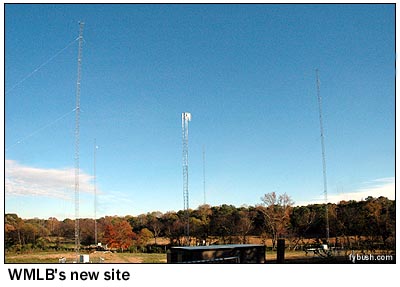 A Return
to Atlanta (Part III)
A Return
to Atlanta (Part III)
When we left you last week, our recap of our whirlwind day-and-a-half visit to Atlanta had reached lunchtime and the WSB (750) site, and what a site it is.
But WSB, for all its I-A clear channel status, is far from the only 50 kW signal in town these days, and our next stop took us from Atlanta's oldest stations to one of its newest.
WMLB (1160 East Point) isn't a brand-new station, exactly - it's the descendant of a station formerly known as WKGE, which used to actually be located in East Point (which is actually south of Atlanta, but never mind.)
A couple of years ago, WMLB did what so many Atlantans have done: it relocated to suburban Cobb County, northwest of the city. The station built four short towers (193') on a piece of land just east of Austell, straddling Buttermilk Creek, and went on the air with 50,000 watts of day power (aimed to the southeast, back at East Point, right over Atlanta in the process) and a whopping 160 watts of night signal.
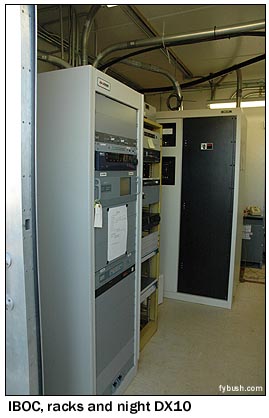
 And after a few
minutes spent watching a skilled tree-trimming crew take down
most of a big old tree on the suburban cul-de-sac that dead-ends
at the entrance to the WMLB site, chief engineer Bob Lipscomb
showed up to lead us down the hill and into this new facility.
And after a few
minutes spent watching a skilled tree-trimming crew take down
most of a big old tree on the suburban cul-de-sac that dead-ends
at the entrance to the WMLB site, chief engineer Bob Lipscomb
showed up to lead us down the hill and into this new facility.
As you read this paragraph, you're pretty much precisely where you'd be if you were standing in the doorway of the little prefab building that houses WMLB's transmitters - to your left is the Harris Dexstar IBOC digital transmitter and a rack of STL and processing gear. Behind that is a Harris DX10 (brought over from the old site in East Point, if memory serves) that's massively overpowered for the purpose to which it's usually put, generating the 160-watt night signal. (It's also a useful auxiliary transmitter for daytime.)
To your right is the Harris 3DX50 that was purchased new for this site.
What can we say about it? It's compact, awesomely energy-efficient, and it has all the personality of my refrigerator. Not everything can be an RCA BTA-50F...but then, those old tube beasts couldn't run for months without human attention, either.
(Down at the bottom of the page, you can see the display on the 3DX50. I'm not sure I really believe the 1.00:1 VSWR, but I've never seen a 3DX50 running at full tilt with more than a few watts of reflected power. It's a brand-new directional array here, after all, and very well tuned.)
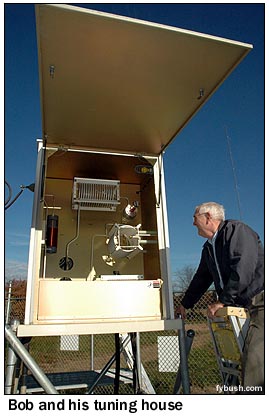 Behind
the 3DX50 sits the largest box in the building, the phasor that
creates WMLB's directional pattern.
Behind
the 3DX50 sits the largest box in the building, the phasor that
creates WMLB's directional pattern.
That pattern still misses a little more of Atlanta than WMLB might prefer, even after this station's owners bought the station on the next channel up, WMLE (1170 Cumming), north of Atlanta, and took it silent.
(That's how WMLB got to go 50 kW by day, though it did nothing whatsoever for nighttime, when everybody still has to protect KSL and a whole bunch of eastern stations that found their way to 1160 before East Point did.)
So WMLB has a few tricks up its sleeve now that it's settled in and on the air from this site. The smaller trick is a realignment of its directional pattern, which was just about to get underway the week we visited. That will aim much more of the signal east into Atlanta. (Even with the horrible ground conductivity here, that should make a difference.)
The bigger one is a pending application to change city of license to Vinings, Georgia, almost due north of Atlanta. That application would also increase night power to 450 watts, using three of these towers, turning WMLB from a class D station to a class B station with interference protection for its night signal.
So where were we? Ah yes - outside in the pleasant Georgia sunshine looking at the towers with Bob. Those tuning houses and towers are part of a turnkey ERI installation, and the way this site is laid out, three of them are on one side of the creek, while the fourth sits across a little footbridge on the other side.
Now, Buttermilk Creek isn't exactly a major waterway, even by Georgia standards, but never underestimate the ability of the Army Corps of Engineers to insert bureaucracy in any form possible. You might just run a ground strap in some conduit under the creek to connect the ground systems on both sides - and I might, too. But the only way the Corps would approve this project was if the ground system went over the creek - and so all those steel cables form a funky little canopy over the water to connect both sides of the ground screen. Go figure...
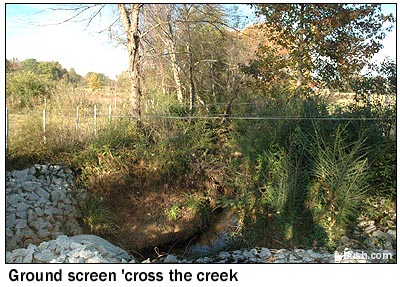
|
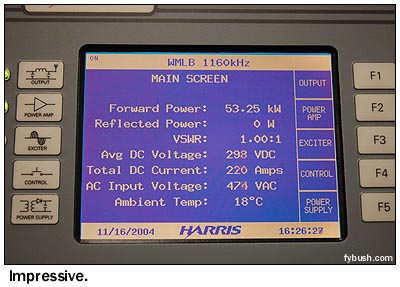
|
Is our day over yet? Even on this short November afternoon, no way! When we wrap up our Atlanta visit next week, we'll see a few more AM sites north of Atlanta, and one bonus site on the south side. (In East Point, no less...)
 It's here - the
2005 Tower Site Calendar is now shipping! Click
here for ordering information!
It's here - the
2005 Tower Site Calendar is now shipping! Click
here for ordering information!
- Previous Site of the Week: Atlanta Revisited, part II
- Next Week: Atlanta Revisited - WDWD, WAZX and more
- Site of the Week INDEX!
- How can you help support Site of the Week? Click here!
- Submit your suggestions for a future Site of the Week!
